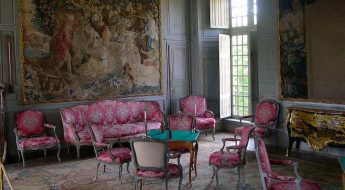A Childhood at Versailles consists of the first 5 chapters of the memoirs of Mme de Boigne (1781-1866), née Adèle d’Osmond, who was a French salon hostess and writer. She was born in the Château de Versailles and lived at the court of Louis XVI and Marie-Antoinette until her family fled to England during the Revolution. Later in her long life, she married a rich soldier of fortune 30 years her senior, hosted a brilliant salon in Paris, and became an intimate of the last French queen, Marie-Amélie, consort of King Louis Philippe (r. 1830-1848). Childless herself, Mme de Boigne addressed her memoirs to her nephew. The memoirs were not published until 1907, under the title Récits d’une tante, or An Aunt’s Tales. They’ve never been published in English, as far as I know, so I’ve decided to translate the first 5 chapters, the ones that take place mainly at Versailles, and post them here on this blog for interested readers to enjoy for free.
The chapters are quite lengthy, so I’ve broken each one into several parts. In Part 1.5, Mme de Boigne describes the behaviour that set malicious tongues wagging about Marie-Antoinette.
“This excellent prince (Louis XVI) had a great deal of difficulty in overcoming a timidity of spirit, joined to boorishly free manners, the fruit of his childhood habits, which did him no favours with those who only saw this uncouth shell. With the best intentions of being obliging to someone, the King would advance towards him until his back was against the wall. If he could not think of anything to say, which happened often, he would give a great bark of laughter, turn on his heels and walk away. The victim of this public scene always suffered from it, and if he was not a regular at Court, he would go away furious, persuaded that the King had wanted to do him some kind of insult. In private, the King complained bitterly of the way he had been raised. He used to say that the only man for whom he felt hatred was the Duc de La Vauguyon7, and in support of this sentiment he cited instances of the abject toadying addressed by the Duc to his brothers and himself. Monsieur had less repugnance for the memory of the Duc de La Vauguyon.
M le Comte d’Artois shared the King’s opinion. His happy disposition, his charm, perhaps even his frivolity, made him the spoiled favourite of the whole family. Though he committed stupidity after stupidity, the King scolded him, pardoned him, and paid his debts. Alas, the one that could never be made good was the discredit heaped on his own head and on the Queen’s!
The King only ever played tric-trac and only for small sums. He once said to a high stakes gambler who was playing at his table, “It’s all right for you to play for high stakes if it amuses you; you’re playing with money that belongs to you, but as for me, I’m playing with other people’s money.” Yet while he was making remarks of this kind, M le Comte d’Artois and the Queen were playing for stakes so enormous that they were obliged to admit the most unprincipled people in Europe into their intimate society in order to make up their table. From this bad habit, for it was a passion neither for the one nor for the other, came all the calumnies that swamped our poor unfortunate Queen’s life with so many sorrows, even before her historical misfortunes had begun.
Who would have accused the Queen of France of selling herself for a diamond necklace if she had not been seen at a table loaded with gold aspiring to win some of it from her subjects? At bottom, no doubt, she attached very little value to the money, but when one plays, one wants to win, and it is impossible to avoid the outward appearance of greed. In any case, princes, accustomed to others giving in to them, are nearly always bad players, which is yet another reason for them to avoid high stakes. But if the Queen did not enjoy gambling, why did she play? Ah, it is because she had another passion, that of being fashionable. She decked herself out to be fashionable, she racked up debts to be fashionable, she gambled to be fashionable, she indulged in free thinking to be fashionable, and she flirted to be fashionable. To be the most fashionable and prettiest woman in society seemed to her the most desirable title, and this eccentricity, unworthy of a great queen, was the sole cause of the faults that were so cruelly exaggerated.
The Queen wanted to be surrounded by all the most agreeable young men that the Court had to offer. She accepted the tributes that they offered to the woman much more readily than those addressed to the sovereign. The result was that a futile young man was treated with more favour and distinction than a serious man who was useful to the country. Envy and jealousy were at the ready to calumniate these trivialities. Beyond doubt, the most blameworthy was the permission that the Queen gave to this troop of imprudent young men to speak carelessly of the King in her presence, and to make jokes about his awkward manners, jokes she was truly wrong to take part in.
A too great desire to please also involved her in mistakes of a different kind, ones that made enemies for her. She had a great deal of influence, and was happy to let it be known; however, she never seriously meddled in business, and her influence was only exploited as a tool with which to succeed in society. She wanted to distribute patronage, and she had the bad habit of promising the same position to several people. There was hardly a regiment whose colonel was not appointed at the Queen’s request, but as she had promised the first vacancy to ten families, she made nine of them unhappy, and all too often the other one was ungrateful. As for the libellous stories told about about her love life, they were calumnies. My parents, well placed to see and hear what happened in private, always told me they were without any foundation.
The Queen had but one great love, and perhaps one slip. The Comte de Fersen, a Swede, angelically handsome and very distinguished in every way, came to the Court of France. The Queen played the coquette for him as she did for all foreigners, for they were in fashion. He fell sincerely and passionately in love; she was certainly touched, but resisted her inclinations and forced him to go away. He left for America and spent two years there, during which he was so ill that he came back to Versailles looking ten years older, and having almost lost all the beauty of his person. It is believed that the Queen was touched by this change. Whatever the reason, it was scarcely doubted by their intimates that she gave way to M de Fersen’s passion.
He justified this sacrifice with a boundless devotion and an affection that was as sincere as it was respectful and discreet. He breathed only for her, and all the habits of his life were calculated with a view to compromising her as little as possible. This liaison, though guessed at, therefore never caused any scandal. If the Queen’s friends had been as discreet and disinterested as M de Fersen, this unfortunate princess would have been slandered less.”
7. Lieutenant General and governor of the three sons of the Dauphin (1706-1772).
This concludes Part 1.5. Coming next week in Part 1.6: a passage about the Queen’s grasping friend, the Duchesse de Polignac.
Did you know that Versailles Century has both a Facebook page and an Instagram gallery (@versailles_century)? Please ‘like’ and follow!


















Leave a Comment